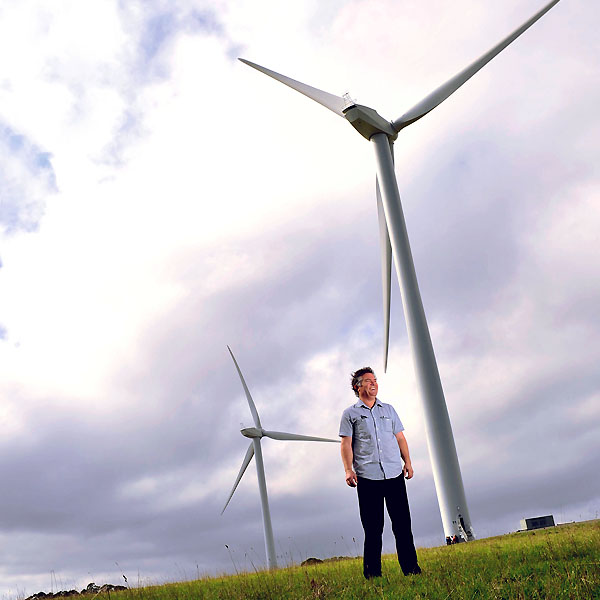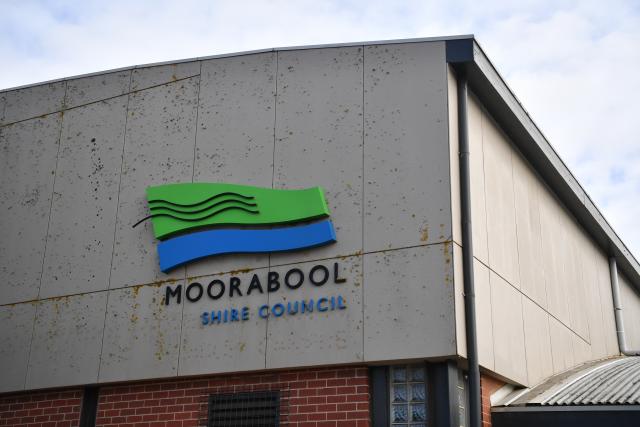Proposals for wind farms have ended friendships and divided communities. Claire Knox talks to those on both sides of the issue.
SHE pulls out a glossy family portrait, protected by a layer of laminate, the memory of a cheery birthday celebration preserved for years to come.
The eyes of both Mary Cassar and her husband Eddie twinkle as they talk about their five grandchildren, whose tiny pastel handprints sprinkle a cubbyhouse wall in their flourishing Mount Wallace garden.
It’s the first time that afternoon that the anxious glances have been swept off their faces.
We’re sitting in the couple’s pristine dining room, looking out over Mary’s rose garden and Eddie’s wide vegetable garden – and in the distance the Lerderderg State Forest and Macedon Ranges.
The Cassars are awash with concern and sadness, afraid the rural vistas that attracted them to their 13-hectare property will be destroyed by 107 wind turbines soon to stretch around their dream home.
The turbines are part of German energy company West Wind’s $750 million Moorabool Wind Farm, which aims to generate 321 megawatts of power, enough for more than 125,000 homes.
The project was first mooted, the Cassars say, by a neighbouring farmer, keen to attract investment for the farming area around Ballan.
“The nearest turbine will be right there, just 1100 metres away,” Mary says.
“It will be a huge blow to us. Our house faces north – we’ll be covered in shade.”
Eddie, who has a soft, even voice and kind eyes, says he always wanted to retire away from the concrete landscape of Sunshine they called home for 20-odd years. They bought the Mount Wallace property in 1989 and worked hard to build a home, pouring hours of work and their life savings into it, moving in two years ago.They first heard news of the turbines’ approval a year before they moved in, but “their hands were already tied,” Mary says.
“This was supposed to be our reward. Someone said we should just sell up, and I thought, Wow, that would be stupid, we have put so much into this,”Mary says.
“Could we sell our house any more? Who knows? People don’t want to buy here any more. It’s devalued our property.”
The Cassars feel disempowered. Several times they sigh and pause, drawing deep, worried breaths.
Both Eddie and Mary are patently anxious. Eddie’s olive skin turns pale as he tells of heart palpitations and breathing problems, a symptom of his anxiety.
They listen to stories about how wind farm turbines cause headaches and sleeplessness. They’re afraid of the low frequency noise, the “infrasound”.
“We love when our grandkids come up for the whole holidays,’’ Eddie says, ‘‘but they won’t be able to come when these go up – we don’t want the kids affected.”
He has had to cut back shifts at work; ironically, he is an engineer working in the aviation industry, maintaining and building turbine blades for planes.
Eddie says friendships have eroded between those who oppose the wind farm, and the landowners who will reportedly be paid for up to $10,000 a year over a 25-year contract for each turbine they allow on their property.
Last month , the Cassars joined more than 200 people at a wind forum at Buninyong Town Hall, one of several across the country, organised by Ballarat-based senator and wind energy sceptic John Madigan.
He says the forums were called after the federal government failed to act on recommendations published in a Senate inquiry final report into wind farms, issued in June.
Pat Griffin, mayor of Moorabool and a vocal opponent of wind farm development , also attended.He says more research into the health effects of turbines is needed.
“Some things sound good in theory but in practice they’re not so good. I’ve sat in bedrooms next to turbines and heard the noise. For people like the Cassars, they are anxious and have every right to be, even on the basis of aesthetics and property prices.
“It’s a vexed issue.Wind companies are using emotional blackmail, saying they’re there to save the planet, when really it’s all about money.”
Griffin has the support of the shire’s six other councillors, and he says all were happy with controversial and restrictive wind farm legislation brought in by state Planning Minister Matthew Guy in August.
The law forbids turbines being built within five kilometres of towns or two kilometres of homes without landowners’ consent.
Blanket bans on all turbines were also introduced for the Macedon Ranges and other popular areas across the state.
The law ignited fury among the green energy community, but not for Moorabool council.
“It would have been great to be retrospective,’’ Griffin says. ‘‘There are still over 1000 turbines that have been approved for Victoria, but not yet built. The laws should apply to them too.”
Guy says it was disappointing the reforms would not include the Moorabool project and blamed the former Labor government for rushing the planning process.
He says the new rules “provide certainty” for the renewable energy sector, and that buffer zones would allow opportunities to build more wind farms without upsetting residents and affecting important social and environmental assets.
But the pro-wind campaigners say Guy’s claims are senseless and the legislation superfluous, potentially driving the industry out of the state.
AN ARRESTING SIGHT
THE turbine blades at Hepburn Wind community wind farm are quite arresting. Two huge, white forms, they stand guard over the undulating pastures of Leonards Hill, 10 kilometres south of Daylesford.
Members of the Woodend Integrated Sustainable Energy and Moorabool Environment Group, along with Friends of the Earth campaigner Ben Courtice and Hepburn Wind’s project officer Tracey Anthony, hover at the base of the hill, animatedly discussing the finer points of renewable energy.
From 500 metres away, the hum of the blades is mesmerising. Although you can certainly hear the turbines from this distance, it’s a muted sound
The group moves up the hill’s crest, to the structure’s base and the noise is much more audible. Both of the 2.05 megawatt Hepburn turbines will produce enough energy for about 2300 households, the company says, and it’s the first community-owned wind farm in Australia. When Hepburn Council issued the planning permit in 2007, 325 submissions of support were collected, with only 18 objections.
WISE member Barry Mann longs for a similar community-owned farm for the Macedon Ranges community, but plans for a three-turbine project were flushed away in August by Guy’s law.
The site, on land leased for a pine plantation along Fingerpost Road. is more than 1.3 kilometres from the nearest house.
Mann says: “Although the vast majority supported our project, there were two objectors within 1.8 kilometres of the turbines, so even if the blanket ban wasn’t there they would have finished us off.”
The group was awarded a $50,000 grant from Sustainability Victoria under the previous government to build an anemometer mast to measure wind speed.
“We have to try and expose misinformation, and we’ll now have information that you can’t argue with.” Mann says.
On March 14 the group released statistics measured by the anemometer mast. Since November 7, 5,310,000 kilowatts per hour had been generated, which they say could have powered 2380 homes, avoided burning 6000 tonnes of coal and earned $637,000 (which would have been funnelled back into a community trust fund).
The group is pushing on with its campaign in the hope the ban will be lifted, or that a new government will eventually reverse the laws.
Another WISE member, Al Reid, felt miffed that while their group engaged heavily with the community, the government did not consult at all before the legislation was moved.
“We have a responsibility as citizens who live in an area rich in a natural resource – wind – to harness that.”
WISE reports that a 2010 poll by research consultants QDOS revealed the support for wind power in the Macedon Ranges was the highest in the state at 75 per cent. Just 2 per cent preferred the building of additional coal-fired power stations.
“A CSIRO study found 80 per cent of Australians are supportive of wind farms. How much of an overwhelming support do you need?” Reid asked.
MEG member Natasha Mills said: “The two-kilometre radius is a completely arbitrary number. In what other planning area does this exist? There’s coal exploration going on 100 metres from my house, and the adverse health effects from coal mining have been scientifically proven.”
She says she used to live near 34 ‘‘turbines, big turbines’’ at Codrington, close to Portland, and did not suffer any ill health.
Ballan resident Tom Kingston thinks Moorabool is an ideal location for a project such as West Wind’s.
“If it was pushed further out and was too remote, [the electricity] couldn’t feed into the grid.’’
He says he sympathises with locals who say their properties will be devalued, but that people should be “thinking more collectively”.
He wonders whether anxiety is fuelling the illnesses reported. “But if you tell people it’s just anxiety they will not accept it – these people genuinely believe they are sick. Do we have apprehension embedded in our culture?’’
Another WISE member, Bruce Mildenhall, says: “We live in one of the windiest areas in the state, so it makes as much sense as blanket-banning solar power in Mildura.
“When did concerns over a “view” or aesthetics become a planning principle? If this was enforced in coastal areas you’d get nothing done – freeways, telco towers …’’
Sunshine resident Ben Courtice, who blogs about the wind debate on yes2renewables, also went to the Buninyong forum. “People reeling off all of these health concerns is a worry, especially since some of them aren’t even near a turbine yet.’’
He cites a slew of reports that counter the claims of ill health.
These include a Victorian Health Department review that stated “the weight of evidence indicated that there are no direct health effects from noise (audible and inaudible) at the levels generated by modern wind turbines”.
Furthermore, after Friends of the Earth submitted a freedom of information request, it was revealed health officials from the NSW Health Department had issued similar statements, that there was no evidence for “wind farm syndrome.”
The Cassars say they are not opposed to community farms like the WISE proposal.
“If it doesn’t affect anyone, I give it all my blessing,’’ Eddie says. ‘‘I don’t necessarily agree with a blanket ban. Our situation is completely different though. We’re talking 107 turbines at 150 metres.”
DROUGHT-PROOFING AND WORRIES
GEOFF WELLS feels anxious too. He and his wife, Jackie Warner, have elected to host nine turbines on their 405-hectare Ballan property.
The turbines will effectively ‘‘drought-proof’’ their cattle and sheep farm – hit hard through the dusty drought years that have characterised the last decade.
Wells won’t disclose how much he’ll earn per turbine, but he says it’s a significant amount.
‘‘It’ll mean we can open a cattle feedlot – they can graze right up to the base of the turbines – and importantly we’ll be able to hire more staff, which feeds directly into the economy. We’ll at least get another fulltime worker – just think of how many farms able to do that?’’
The 56-year-old father of three says the Moorabool farming industry will be kept alive, with farmers choosing to spend money in local towns rather than moving away.
But he’s worried the new laws and the vocal opposition to turbines might eventuate in the wind farm permit – and his family’s financial security – being revoked.
‘‘We’ve been anxious too, you know, over the last 10 years … the drought really tested us: years of no income, huge debt, it was pretty scary.’’
Wells says the council’s dramatic anti-wind stance ‘‘beggars belief’’.
He says he’s a bit of a ‘‘greenie’’ at heart. ‘‘It’s just too easy to keep digging up the brown coal. We’re not forward-thinking enough.’’
West Wind project manager Phil Burn says the project would provide 100 construction jobs, 20 continuing maintenance roles and a $400,000 injection of rates into Moorabool Council.
He says that while the new legislation had severely restricted further investment in Victoria, the company ‘‘expected to announce building plans soon.’’
Blanket bans were particularly devastating, Burn says.
‘‘They [the government] are just with the strike of the pen listening to vested interests, taking out swathes of land. That does not happen with any other land users – timber plantation, coal mines, etc.’’
Griffin questions why West Wind couldn’t reduce the size of the turbines, the number or the design, ‘‘to reduce noise’’. But Burn maintains the company consulted the community thoroughly and the project was approved, with a ‘‘small group still unhappy with outcome.’’
He says the company would not change the project plan. ‘‘We’ve been through the process, we have exceeded the guidelines. You just don’t change projects, it doesn’t work that way.’’
Burn says he agreed the approval process for the wind farm had clearly caused anxiety and stress among the opponents.
‘‘I do feel for people like Eddie and his wife, but the extent to how we can deal with anxiety is limited, it’s incredibly challenging.’’
He says while he thought research into health effects had been thorough, he welcomed more if it would abate people’s concerns.
Hepburn Wind project officer Tracy Anthony says she believes a sense of disempowerment was at the root of the detractors’ anxiety.
She says a couple who owned a holiday house down the hill from the Hepburn turbines had been ‘‘missed’’ by consultation and arrived one weekend to find two turbines behind their property.
‘‘They were understandably shocked to find the turbines there. It was a six-month journey for them.
‘‘Immediately they jumped on the net and found all of the negative press, so we worked with them and they finally came to the conclusion that they could choose whether or not they would let themselves become a wreck.
‘‘The lady’s solution was to put a water feature in her back yard, and when it became her solution things really shifted for her. She took control of the anxiety.
‘‘Yes turbines make a sound – I live very close to them and won’t deny that. But it’s a normal sound, like living near a freeway.’’
Anthony says there is ‘‘absolutely no proof’’ of low frequency noise or infrasound.
Opposition planning spokesman Brian Tee has slammed the new rules, saying they would cripple the industry and cut potential revenue for farmers, while Greens MP Greg Barber has suggested Premier Ted Baillieu has close links with anti-wind farm groups and has killed off one of regional Victoria’s biggest growth areas.
AND FOR NOW…
BACK in Mount Wallace, the Cassars have carefully stacked piles of letters, reports and other wind farm-related documents on their kitchen bench.
It’s a tangible symbol, for them, of their protest against Moorabool Wind Farm, one they will not give up on any time soon.
In the closing paragraph of their lengthy submission against the wind farm, they ask ‘‘would you like to live underneath them?’’
WEBSITES
www.landscapeguardians.org.au
www.yes2renewables.org
www.wisegroup.org.au
www.w-wind.com.au
www.mooraboolmeg.org.au







